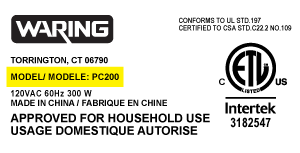WFW9300VU04 Whirlpool Washer - Instructions
Keep searches simple. Use keywords, e.g. "leaking", "pump", "broken" or "fit".
Hinge broke
-
Lindsey from STEWART MANOR, NY
-
Difficulty Level:Very Easy
-
Total Repair Time:30 - 60 mins
3 of 3 people
found this instruction helpful.
Was this instruction helpful to you?
Thank you for voting!
The inlet valve begins to restrict water flow into the washer based on normal calcium buildup. At a certain point, the washer will start giving an F20 error code indicating it is not getting enough water.
This is a straightforward replacement. Move the washer to an area where you can work on it. Unplug the washer from the wall. Turn off the water and disconnect the hot and cold water hoses at the washer. Remove the back of the washer. Slide out the top of the washer. Remove the small hose from the valve to the remainder of the washer. Disconnect the two control wires to the valve. Replace the valve. Replace the small water hose. Reconnect the wires. Replace the top and back of the washer. Connect the water back up. Plug in and try a test load. The water should flow fast enough to reach the back of the machine.
Parts Used:
-
Dennis from AUSTIN, TX
-
Difficulty Level:Easy
-
Total Repair Time:30 - 60 mins
-
Tools:Nutdriver, Pliers, Screw drivers
3 of 3 people
found this instruction helpful.
Was this instruction helpful to you?
Thank you for voting!
Broken hinge
Removed door from washer, remove hinge from door. Then slip in hinge and tighten hinge to door. Then attach door. It works and the most important thing the wife is happy
Parts Used:
-
Anthony from JACKSONVILLE, FL
-
Difficulty Level:Really Easy
-
Total Repair Time:30 - 60 mins
-
Tools:Nutdriver, Screw drivers
3 of 3 people
found this instruction helpful.
Was this instruction helpful to you?
Thank you for voting!
tub would not turn
take the back cover off and put belt on. the belt is a tight fit and requires sone effort, but can be done.
Parts Used:
-
claude van from big sandy, TN
-
Difficulty Level:Really Easy
-
Total Repair Time:15 - 30 mins
-
Tools:Screw drivers
3 of 3 people
found this instruction helpful.
Was this instruction helpful to you?
Thank you for voting!
Pump not working
-
Darrell from Lady Lake, FL
-
Difficulty Level:Really Easy
-
Total Repair Time:Less than 15 mins
-
Tools:Screw drivers
4 of 6 people
found this instruction helpful.
Was this instruction helpful to you?
Thank you for voting!
the pump wasnt puping out the water
firts remover the three bolts that held the front panel on, and removed that. Then removed the screw that held the pump in place. then removed the hoses from the pump. After that put hoses on new pump and srewed back in place . the put front back on.
Parts Used:
-
Evette from Mayfield, NY
-
Difficulty Level:Easy
-
Total Repair Time:15 - 30 mins
-
Tools:Pliers, Socket set
3 of 4 people
found this instruction helpful.
Was this instruction helpful to you?
Thank you for voting!
Washer leaking
-
Carolyn L. from CLAYTON, NY
-
Difficulty Level:Really Easy
-
Total Repair Time:30 - 60 mins
3 of 4 people
found this instruction helpful.
Was this instruction helpful to you?
Thank you for voting!
Torn bellow lip
Replace bellow with help from Youtube video.
Parts Used:
-
Christopher from MORGAN HILL, CA
-
Difficulty Level:A Bit Difficult
-
Total Repair Time:More than 2 hours
-
Tools:Nutdriver, Socket set
3 of 4 people
found this instruction helpful.
Was this instruction helpful to you?
Thank you for voting!
The washing machine was not draining. It was showing a code on the washer of 02.
We removed the front cover to the washer. Then we removed the drain pump piece that was broken. We put the new drain pump in and secured the screws. We also inspected all the hoses to make sure the hose clamps were intact. Then leaving the front cover off the machine to inspect for leaks we turned on the wash cycle. No more problems.
Parts Used:
-
Robin from Gary, TX
-
Difficulty Level:Really Easy
-
Total Repair Time:Less than 15 mins
-
Tools:Screw drivers
3 of 4 people
found this instruction helpful.
Was this instruction helpful to you?
Thank you for voting!
Torn bellows was leaking and eating clothes
Followed directions as shown in your repair video, having done this for the first time it took a bit longer than a repairman would have but was able to git-r-done. The most difficult part was fitting the adjustable wire back around the front of the washer, in the video it is made to look really easy however in real life it is a little more difficult and could not be attached so easily and took quite a bit of time to make sure it was attached correctly. thank you for your help.
Parts Used:
-
James from NEWBERG, OR
-
Difficulty Level:A Bit Difficult
-
Total Repair Time:More than 2 hours
-
Tools:Nutdriver, Pliers, Screw drivers, Socket set
2 of 2 people
found this instruction helpful.
Was this instruction helpful to you?
Thank you for voting!
Bellow leaking water
Removed the outer spring with pliers. Pushed the bellow into the drum. Loosened the clamp on the bellow with a stub nose screwdriver. Removed the bellow. lined bellow up with soap fiting. Reversed procedure to reinstall.
Parts Used:
-
Eric from Vacaville, CA
-
Difficulty Level:A Bit Difficult
-
Total Repair Time:30 - 60 mins
-
Tools:Pliers, Screw drivers
3 of 5 people
found this instruction helpful.
Was this instruction helpful to you?
Thank you for voting!
Error codes SUD and Fo2
Remove three screws on bottom panel lift up and remove panel.The water pump in right in front. One screw holds it in place and the input and output hoses are on the back side.The hose clamps are a little hard to take off I found that before taking the one screw off the pump remove these two lines.Putting the pump back in secure the pump with the one screw. The output line is easy the intake line can be a bit of a more work to get it on because the rubber is so thin.Getting this hose and clamp was tough. Most of all use a wet vac to remove water in washer and vac out the line to drain doing this will be water free during replacing water pump.Run a cycle to make sure the lins do not leak. The other is the people that has posted this replacement are very good
Parts Used:
-
Gregory from LEXINGTON, SC
-
Difficulty Level:Easy
-
Total Repair Time:15 - 30 mins
-
Tools:Pliers, Screw drivers
2 of 2 people
found this instruction helpful.
Was this instruction helpful to you?
Thank you for voting!
Bellow was torn and water was leaking onto the floor
(These instructions improve on the excellent instructions provided by customer Franck from Anandale, Va.)
The first step is to remove the retainer wire and spring that holds the outside of the bellow in place.
To do this, Open the washer door as far as you can to get it out of the way. Look underneath of the front of the bellow on the outside of the washer where it meets the door. Put your head almost on the floor and look up.
You will find a spring stretched about 3" connected to a small diameter wire (1mm.) that runs all the way around the outside portion of the bellow.
Use a small screwdriver or needle-nosed pliers to pull and pry the spring away from the rubber bellow. Be careful not to damage the spring or ring. Once you have grip on it, pull it carefully toward you then up and off of the bellow.
The front portion of the bellow is now free and can be peeled off. Start at any point and pull the rubber bellow in toward the opening of the washer, it comes off easily.
When you get to the detergent outlet on the upper left side, grab the plastic tube and carefully pull the bellow from around it. There is no adhesive or clamp holding this in place, just friction. Remove the rest of the front portion of the bellow.
Push as much of the bellow into the washer as possible to get it out of the way.
Once this is off comes the slightly tricky part. Look up at the top right portion of the bellow that is still attached. You may need to feel with your hand but you should be able to see it. This is where the flashlight or worklight will be helpful. You are looking for the screw/nut end of a giant hose clamp. This hose clamp goes around the entire bellow and secures it to the portion that holds the basket.
This is where the stubby screw driver comes in handy. There is not nearly enough room for a standard one and a nut driver or wratchet are too big. The nut will be pointing down and will need to be replaced the same way.
Loosen the hose clamp almost all of the way, perhaps 5 turns on the nut. It is not necessary to have the hose clamp come completely apart.
You can now remove the entire hose clamp from around the bellow by pulling it forward.
You will need to remove the hose clamp from the washer. To do this, squeeze it in from the sides about 6", don't kink it. Push it down toward the floor between the basket and the metal front panel. You will now be able to remove it from the top of the opening and be able to pull the bottom portion out.
Pull the old bellow completely out, very easy to do.
Time to install the new bellow. Figure out which side goes in and which faces out. The big hint is that the water inlet is on the upper left side.
You will notice at the top of the bellow on the portion that goes inside of the washer, you will find a small triangular shaped tab about 1/4" high. This is your centering mark. This will be at the very top. If you keep this at the top, everything will line up perfectly.
This next step takes a bit of dexterity because you need to slide both the bellows and the hose clamp into the machine with the triangular shaped tab on the bellow at the top as above. Unbend anything that might have bent on the clamp. Put a tiny bit of lube oil or Vaseline on the clamp screw thread to make it easier for your fingers to tighten it with the stubby screwdriver later. The hose clamp must go in now because once the bellow is slid over the detergent inlet tube the hose clamp can not be installed. Slip the bellow over the edge of the portion that holds the basket where you removed the old one. I started at the top and worked left so I could install the detergent inlet tube. Pull this through the bellow carefully. It doesn't take a lot of force. I found that wetting it with water made it easier to slide the bellow over it.
As you are pressing the bellow on this lip, you will notice that there is a 1/2" high back stop all of the way around. This is great because as you press it on, there is a positive stop and you can't go further than necessary. Continue to press it in all of the way around.
With the nut at the top or top right with the nut facing down to the floor while holding it vertically, squish it slightly inward, put the bottom portion in first then the top portion. Orient is as it was when you took it off. Slide it around the bellow. You will feel a positive stop. Run your fingers around the entire bellow to be sure the clamp is seated in the channel on the bellow and that the bellow is against its backstop. This assures you won't have a bad leak upon your next wash.
Grab the stubby screwdriver and tighten down the hose clamp. I did about a medium force when tightening. It doesn't take a lot of force.
Now it is time to pull the remaining part of the bellow out of the basket and fit it into place. Press it around the outside portion of the opening so it hooks over the lip. Now take the retainer wire and spring assembly and use it to clamp the bellow over the lip. After fitting the wire around
The first step is to remove the retainer wire and spring that holds the outside of the bellow in place.
To do this, Open the washer door as far as you can to get it out of the way. Look underneath of the front of the bellow on the outside of the washer where it meets the door. Put your head almost on the floor and look up.
You will find a spring stretched about 3" connected to a small diameter wire (1mm.) that runs all the way around the outside portion of the bellow.
Use a small screwdriver or needle-nosed pliers to pull and pry the spring away from the rubber bellow. Be careful not to damage the spring or ring. Once you have grip on it, pull it carefully toward you then up and off of the bellow.
The front portion of the bellow is now free and can be peeled off. Start at any point and pull the rubber bellow in toward the opening of the washer, it comes off easily.
When you get to the detergent outlet on the upper left side, grab the plastic tube and carefully pull the bellow from around it. There is no adhesive or clamp holding this in place, just friction. Remove the rest of the front portion of the bellow.
Push as much of the bellow into the washer as possible to get it out of the way.
Once this is off comes the slightly tricky part. Look up at the top right portion of the bellow that is still attached. You may need to feel with your hand but you should be able to see it. This is where the flashlight or worklight will be helpful. You are looking for the screw/nut end of a giant hose clamp. This hose clamp goes around the entire bellow and secures it to the portion that holds the basket.
This is where the stubby screw driver comes in handy. There is not nearly enough room for a standard one and a nut driver or wratchet are too big. The nut will be pointing down and will need to be replaced the same way.
Loosen the hose clamp almost all of the way, perhaps 5 turns on the nut. It is not necessary to have the hose clamp come completely apart.
You can now remove the entire hose clamp from around the bellow by pulling it forward.
You will need to remove the hose clamp from the washer. To do this, squeeze it in from the sides about 6", don't kink it. Push it down toward the floor between the basket and the metal front panel. You will now be able to remove it from the top of the opening and be able to pull the bottom portion out.
Pull the old bellow completely out, very easy to do.
Time to install the new bellow. Figure out which side goes in and which faces out. The big hint is that the water inlet is on the upper left side.
You will notice at the top of the bellow on the portion that goes inside of the washer, you will find a small triangular shaped tab about 1/4" high. This is your centering mark. This will be at the very top. If you keep this at the top, everything will line up perfectly.
This next step takes a bit of dexterity because you need to slide both the bellows and the hose clamp into the machine with the triangular shaped tab on the bellow at the top as above. Unbend anything that might have bent on the clamp. Put a tiny bit of lube oil or Vaseline on the clamp screw thread to make it easier for your fingers to tighten it with the stubby screwdriver later. The hose clamp must go in now because once the bellow is slid over the detergent inlet tube the hose clamp can not be installed. Slip the bellow over the edge of the portion that holds the basket where you removed the old one. I started at the top and worked left so I could install the detergent inlet tube. Pull this through the bellow carefully. It doesn't take a lot of force. I found that wetting it with water made it easier to slide the bellow over it.
As you are pressing the bellow on this lip, you will notice that there is a 1/2" high back stop all of the way around. This is great because as you press it on, there is a positive stop and you can't go further than necessary. Continue to press it in all of the way around.
With the nut at the top or top right with the nut facing down to the floor while holding it vertically, squish it slightly inward, put the bottom portion in first then the top portion. Orient is as it was when you took it off. Slide it around the bellow. You will feel a positive stop. Run your fingers around the entire bellow to be sure the clamp is seated in the channel on the bellow and that the bellow is against its backstop. This assures you won't have a bad leak upon your next wash.
Grab the stubby screwdriver and tighten down the hose clamp. I did about a medium force when tightening. It doesn't take a lot of force.
Now it is time to pull the remaining part of the bellow out of the basket and fit it into place. Press it around the outside portion of the opening so it hooks over the lip. Now take the retainer wire and spring assembly and use it to clamp the bellow over the lip. After fitting the wire around
Parts Used:
-
Robert from GLENVILLE, NY
-
Difficulty Level:Easy
-
Total Repair Time:15 - 30 mins
-
Tools:Screw drivers
2 of 2 people
found this instruction helpful.
Was this instruction helpful to you?
Thank you for voting!
Broken hinge
-
Kevin from JACKSONVILLE, FL
-
Difficulty Level:Really Easy
-
Total Repair Time:30 - 60 mins
-
Tools:Screw drivers
3 of 5 people
found this instruction helpful.
Was this instruction helpful to you?
Thank you for voting!
Water filling up in drum when not in use
Took top off with nut driver, disconnected 2 wires , removed one screw holding inlet value. Then I reversed the procedure putting new one on. Maybe 20 min. Of course unplug power and turn off water supplies before starting the job.
Parts Used:
-
Don from Oceana, WV
-
Difficulty Level:Really Easy
-
Total Repair Time:15 - 30 mins
-
Tools:Nutdriver, Pliers
2 of 2 people
found this instruction helpful.
Was this instruction helpful to you?
Thank you for voting!
































